
Bizarro Back Issues: Spider-Man Beats Venom With Beach Nudity (1989)

When I was a kid, I had a paperback called The Very Best of Spider-Man that I read until the binding wore out. Looking back, I might take a slight issue with that title, but it really was a pretty great selection of stories that had a huge impact on making me a fan of the character: "Whatever Happened to Crusher Hogan" is still a favorite to this day, the heartstring-tugging "The Kid Who Collected Spider-Man," and, probably most importantly, "The Final Chapter" from Amazing Spider-Man #33, which still ranks as the single best comic Marvel ever published.
And then there was the one where Spider-Man fought Venom and won by getting naked on a beach.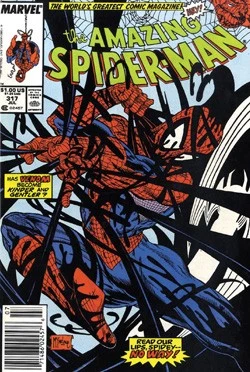 The weird thing about that -- aside from the obvious -- is that it's apparently not the only time naked beach-fighting has been a crucial plot point in a Spider-Man comic. When I couldn't remember the issue number and put the question to Twitter, half of the answers pointed to a story by David Michelinie and Erik Larsen from Amazing Spider-Man #347, and sure enough, there is beach fighting and Eddie Brock chillin' out in the tiniest of Comics Code-mandated speedos.
The weird thing about that -- aside from the obvious -- is that it's apparently not the only time naked beach-fighting has been a crucial plot point in a Spider-Man comic. When I couldn't remember the issue number and put the question to Twitter, half of the answers pointed to a story by David Michelinie and Erik Larsen from Amazing Spider-Man #347, and sure enough, there is beach fighting and Eddie Brock chillin' out in the tiniest of Comics Code-mandated speedos.
The one I grew up with, however, came a few years earlier in Amazing Spider-Man #317, by Michelinie and an up-and-coming young artist called Todd McFarlane, which explains why it was in a Best Of book that came out in 1994. I'm not gonna lie, though: this story is great if you read it when you're twelve, mostly because it's a Todd McFarlane comic with Venom in it.
See, the genius of Venom is that he might just be the perfect character to appeal to kids who a) love Spider-Man, and b) are at the age where they're just getting into heavy metal. Seriously, the guy is just like Spider-Man, except that he's bigger and stronger, wears a black costume, has giant jagged vampire teeth that occasionally drip unidentified green slime, and occasionally switches sides from "bad guy" to antihero "lethal protector." Oh, and also, his costume is from space. When your target audience is spending every afternoon drawing Megadeth logos in Algebra class, that junk sells itself, which explains why it took years of overexposure and a story as unreadable as Maximum Carnage -- which admittedly made a great Super Nintendo game -- to start chipping away at his popularity. When this issue was published, though, Venom was still on the upswing, ascending to to the heights of popularity that would find him ranked in comic shops and schoolyards as one of the greatest villains of all time.
Personally, I wouldn't call that an entirely accurate statement.
He is a pretty sinister bad guy, however, as evidenced by the fact that he starts this issue just cold rolling up to Aunt May's house in an argyle sweater/camelhair jacket combination that I can only describe as timeless.
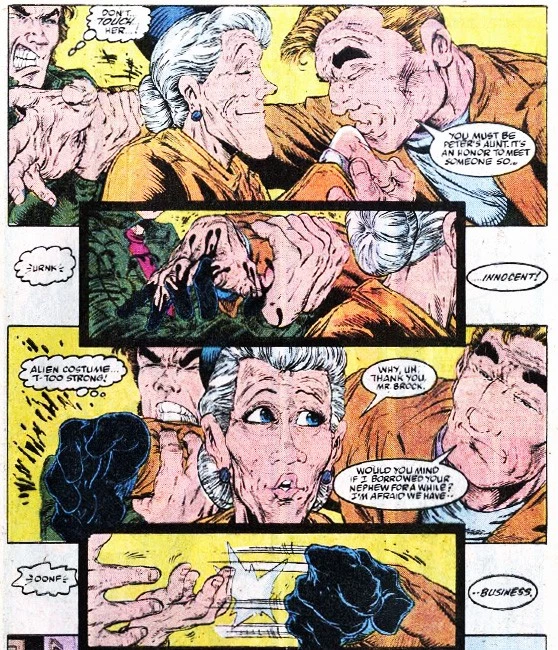
There's a lot of pretty amazing art on this page, with Peter's exaggerated frustration and Aunt May's wide-eyed, oblivious happiness that Peter finally has a friend, but my eyes are always drawn to Eddie Brock's insanely massive eyebrows. Look at those things! If it wasn't for the fact that the alien symbiote takes the form of his clothes, I'd assume he had the entire thing condensed into those gigantic caterpillars on his forehead.
Actually, now that I'm looking at it, Peter has 'em too. And oddly enough, they don't even come close to matching their hair color. Weird.
Anyway, those brows aren't the only ominous tidings Eddie Brock's brought to the Parker household. In showing up at Aunt May's house, he's shown that he's both willing and able to put Spider-Man's family in danger if he chooses. As for how he found out where Aunt May lives...

...it turns out that Peter had a bunch of change-of-address forms in his pocket the last time he was out fighting super-villains. Really. C'mon, Pete, that is bush league. That's some stuff Newspaper Spider-Man would pull.
Of course, considering that Brock already knew Spider-Man's secret identity and where he worked thanks to the symbiote, I'm not really clear on just why the whole thing with the forms was necessary. The only answer I can come up with is that back in the late '80s, they wanted to move away from Peter being a genius and more in the direction of Peter being really, really dumb.
Either way, Brock lays out an ultimatum: A throwdown on Montauk on Long Island, just the two of them, Mano a Mano. Or at least Mano a Mano con Symbiote, but, you know, close enough. The problem is that, like I said above, Venom's stronger than Spider-Man, and he doesn't trigger his Spider-Sense, meaning that in a straight-up fight, Peter's odds aren't looking so hot. So, after another pretty sweet McFarlane splash page...

...Spider-Man elects to go get the a bunch of the most powerful people he knows so they can gang up on Venom and stomp the living crap out of him. And for the record, if you're the good guy, that's not cheating. It's winning.
To that end, he heads over to the Baxter Building to talk to the Fantastic Four. The only one home at the time is the ever-lovin' blue-eyed thing, and ohhhhh dear, what the hell is this?

I've never actually read any Fantastic Four from the late '80s, but a quick look at the covers shows that this isn't just McFarlane taking artistic license. At the time, the Thing had been temporarily mutated into a more jagged pineapple-looking form, although I'm not sure that any other artist took the time to give him what appear to be a rocky pair of suspenders going over his shoulders.
Of course, the art isn't the only thing worth noting on this page. I've always been a big supporter of comics that are willing to catch up a reader who's just picking it up without reading the previous issues -- I mean, that's how I read this one -- but Michelinie goes just a little bit overboard with that, what with having Spider-Man explain a bunch of stuff that Ben Grimm already knows. I like to imagine that Ben's slack-jawed expression in that second panel is a sign that he's rolling his eyes and making talky-talky motions behind Spidey's back.
Also, for anyone keeping track at home: That editor's note from Jim Salicrup is actually a misprint. It should read "Fantastic Four #326." Otherwise, this issue took place nine years before it actually came out.
The Thing agrees to get the FF to back Spider-Man up during his fight with Venom, but when he goes back over to Aunt May's, he's greeted with this sinister sight:

I think we can all agree that the last thing you want is to find your arch-nemesis going through your widowed aunt's laundry.
Needless to say, Brock's sudden interest in Aunt May's linens is just a cover for reminding Spider-Man that if he brings help, some bad things are going to happen to the people he loves. Thus chastised, Spider-Man agrees to keep the Fantastic Four out of things.
Of course, he also promises Mary Jane -- who is understandably worried that her husband's about to go get beaten to death by Venom -- that he'll get some help. So, as you might expect from a thrilling tale of super-hero action, he goes to see a psychiatrist. Yes, really.
As a result, he shows up to the Brawl at the Beach with a new insight:
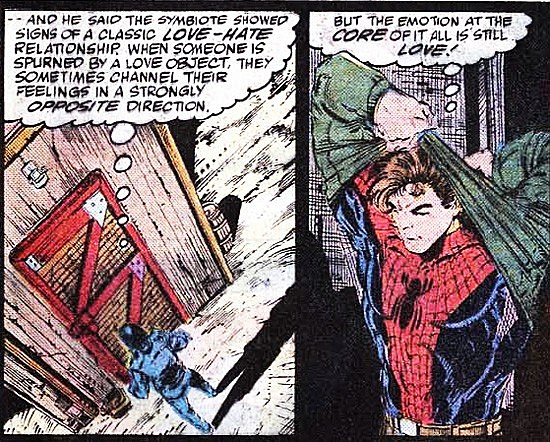
That's our first clue that things are about to get strange.
The fight, though, is awesome. McFarlane's greatest strength as an artist is dynamic action, and he comes through like gangbusters in here. There's really innovative stuff from both him and Michelinie, with Venom pulling Mortal Kombat moves and dragging Spider-Man under the sand on the beach. His mass and power come through perfectly on the page, and the way that McFarlane stages the fights really makes it feel like Spider-Man's just barely escaping whenever he dodges.
Seriously, I don't want to turn this into Sequential Art 101 or anything, but just look at this one:

The way McFarlane breaks that single panel up into three smaller faux-panels by using the pillars in the boat house -- elements within the larger panel itself -- to create distinct moments, isolating Spider-Man in one, Venom's hand breaking through the door, with the third showing his whole mass crashing through? That's incredible! The way it manipulates the readers perception and creates a flow of time within a single moment using the language of comics, even the placement of Spider-Man so that you can tell at a glance that the pillars aren't actual panel borders... it's seriously masterful stuff. Even with the dozens of Spider-Man/Venom fights that had happened by 1994, it's pretty easy to see why they picked this one to go in a book called "The Very Best," and it's even easier to see why McFarlane was blowing up into one of comics' most popular artists.
So yeah: It's a pretty great fight scene. But unfortunately for Spider-Man, it's not going his way. Venom shrugs off every attempt he makes at stopping him, until Spidey finally decides that desperate times call for desperate measures.
And that's when things get weird.
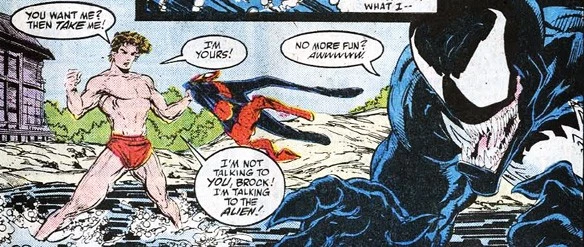
Spider-Man cold strips down on the beach and offers his body to what is essentially a tentacle monster from outer space. Yyyyyyyyyup.
Believe it or not, I haven't devoted that much time to thinking about what super-heroes wear under their costumes, but I have to say: Boxers? Under tights? That doesn't seem comfortable or practical. Even worse is Eddie Brock, who appears to have swaddled his junk in a dishtowel, which raises a whole lot of questions about why you'd bother wearing anything under a symbiote that's actually bonded to your nervous system and takes the form of clothes. Questions that I couldn't answer when I was 12, and can't answer now. Questions I may never be able to answer.
The plan here is to lure the symbiote off of Eddie Brock through the irresistible temptation of his body, with the idea being that the separation from the host will be too much for both symbiote and host to bear. Which, fortunately for Spider-Man, is exactly what happened.

Thus, Peter Parker wakes up on a beach in his underwear with his mouth covered in Venom's leavings.
And with that, the story pretty much ends. Because really, where do you go after that much subtext?
More From ComicsAlliance
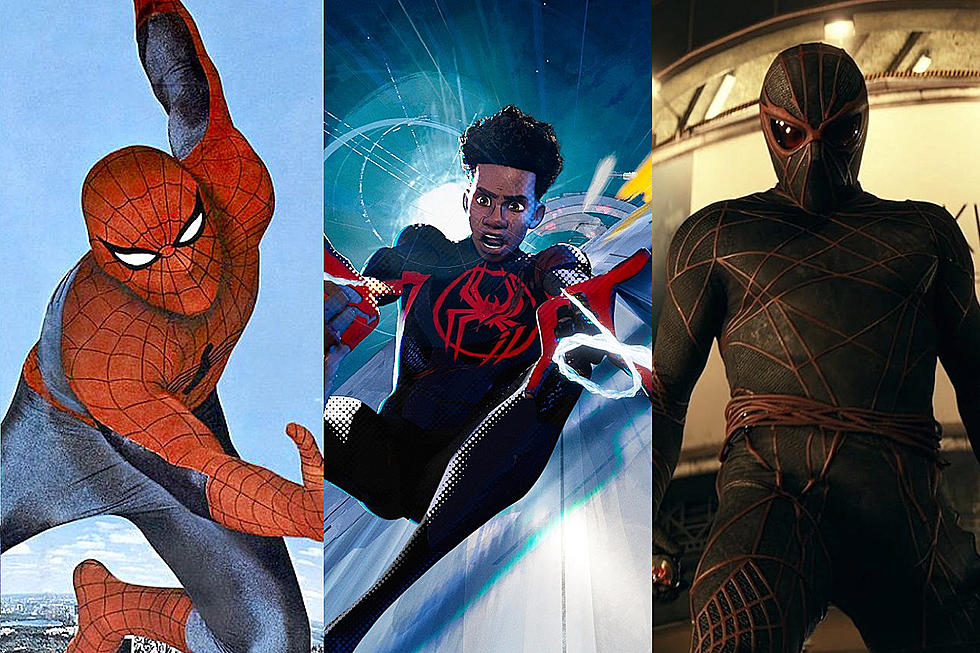



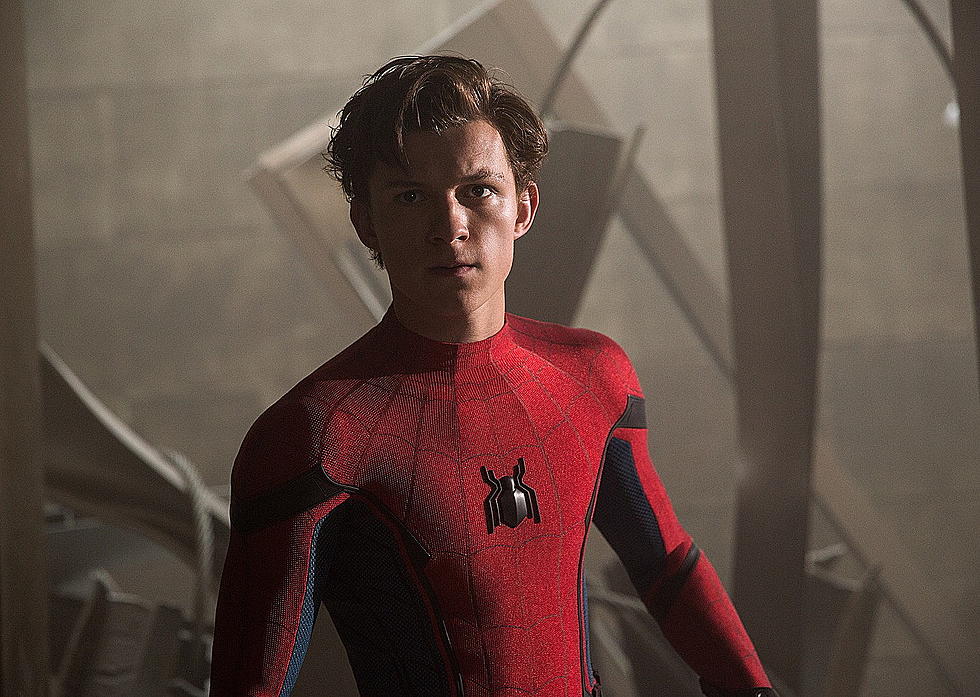



![Eddie Brock Is Back In Black In Costa And Sandoval’s ‘Venom’ #6 [Preview]](http://townsquare.media/site/622/files/2017/03/Venom_6_Feat.png?w=980&q=75)
